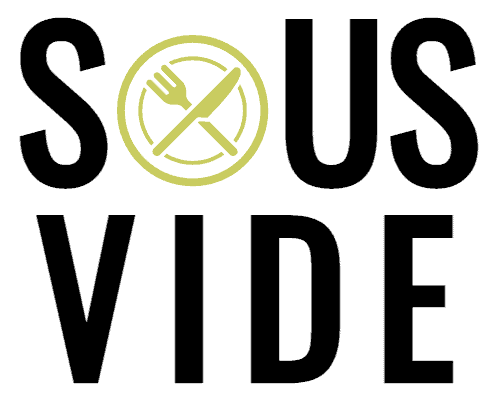Freezing bacon is a great way to make it last longer and preserve it for later use. But dealing with frozen bacon while making breakfast can be a pain in the butt, especially when you’re in a rush to eat and get going for the day.
I’ll share a few ways to defrost bacon in this article, depending on your equipment. We’ll cover a few common problems and discuss which is the fastest. I’ll also give you my go to method for perfectly par cooking bacon so I can serve it in just a minute in the morning.
Table of Contents
How to Defrost Bacon Step-By-Step
There are many ways to do it, but these are my go-to methods for defrosting bacon. If you’re in a hurry and have a microwave, that’s always the best place to start.
Microwave
This is the quickest method, but has some drawbacks. It hardly takes a few minutes and does the job really well. Here’s how to do it in a few simple steps,
- If they’re frozen together, separate the bacon strips with a sharp knife.
- Line a microwave-safe plate with a paper or kitchen towel. Then place the separated bacon strips atop the liner.
- Select the defrost function on your microwave or turn on the low power mode. Microwave it for 1-2 minutes.
- Then flip the strips and microwave for another minute or two. Adjust the time in the microwave depending on the quantity of bacon you’re defrosting.
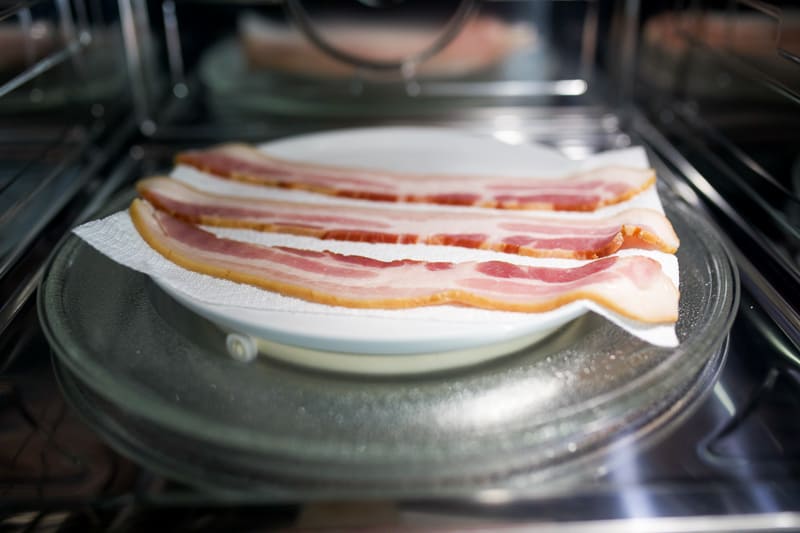
The drawbacks of this method are that you can only defrost smaller quantities at a time, and it’s difficult to control the level of doneness with any precision. It also doesn’t work well for larger quantities of bacon, only a few slices at a time. And if separating the bacon from frozen proves too difficult, there’s not a great work around.
Sous Vide
If you want the perfect bacon, every time, sous vide is a never-fail method—no matter the quantity.
You can defrost and cook with next to no effort. And the best part is that if your bacon is already vacuum sealed, all you have to do is drop in the water bath and walk away. You don’t even need to open it.
My favorite method is overnight bacon, but you can prep frozen bacon the same morning. Here’s how to do it:
- Using an immersion circulator, pre-heat a water bath to 140°F (60°C).
- Place a vacuum sealed bag containing the frozen bacon in the water bath, and allow it to defrost for 10-30 minutes.
- Do not allow the meat to defrost for longer, in order to avoid a temperature environment which is conducive to the growth of contaminants like bacteria.
- Cook immediately.
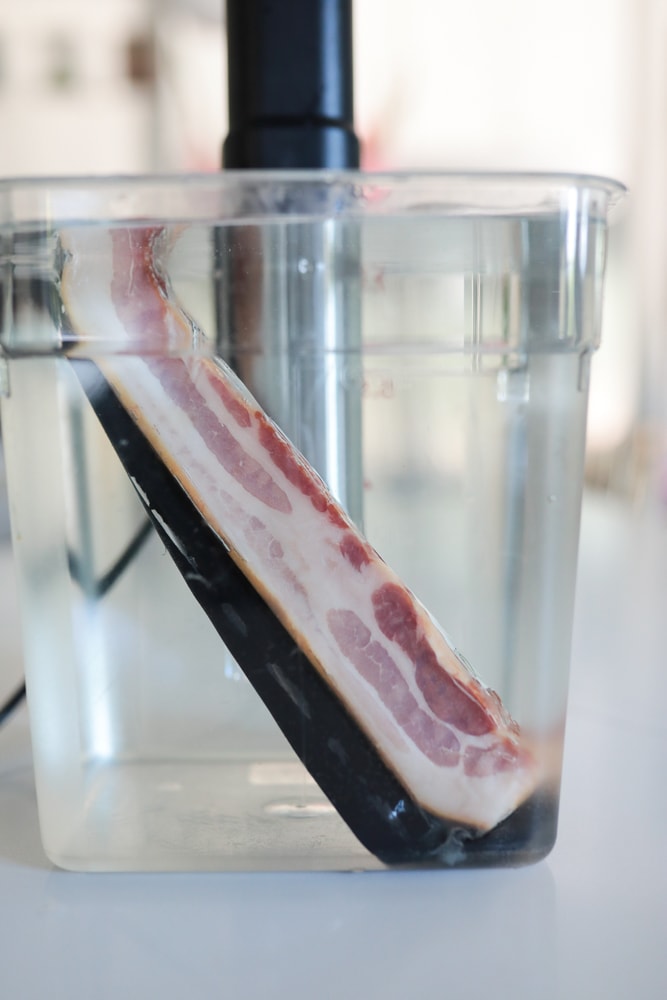
From a food safety standpoint, it’s better to overnight cook the bacon. And if you do defrost using sous vide, then sear immediately after. This will move the food product out of the temperature “danger zone” and also will kill any bacteria that was present on the surface of the meat.
Overnight cooking sous vide bacon is a great option. This par-cooks the bacon so you can simply heat it up in a minute by searing in a pan to finish it. Either refrigerate or freeze after par-cooking so you always have bacon ready in a flash.
Frying Pan
This method helps you thaw and cook the bacon in the same skillet, making it efficient and fast while you multi-task the rest of the elements of your meal. Depending on the size of your skillet, you can also defrost more bacon at once than with a microwave.
Here is how you do it:
- Using a sharp knife, separate the frozen bacon strips.*
- Heat a pan or skillet over medium heat. Then place the frozen bacon strips in a single layer in the hot pan.
- Cover the pan to speed up the defrosting process. The lid will trap in hot air and heat the bacon from all sides. Stir the strips around to ensure they thaw evenly.
- Once defrosted, remove the lid and increase the heat to medium-high. Then continue cooking the bacon strips until they reach the desired crispiness.
*if the bacon is too difficult to separate safely, jump to step 2 and separate as soon as you are able to.
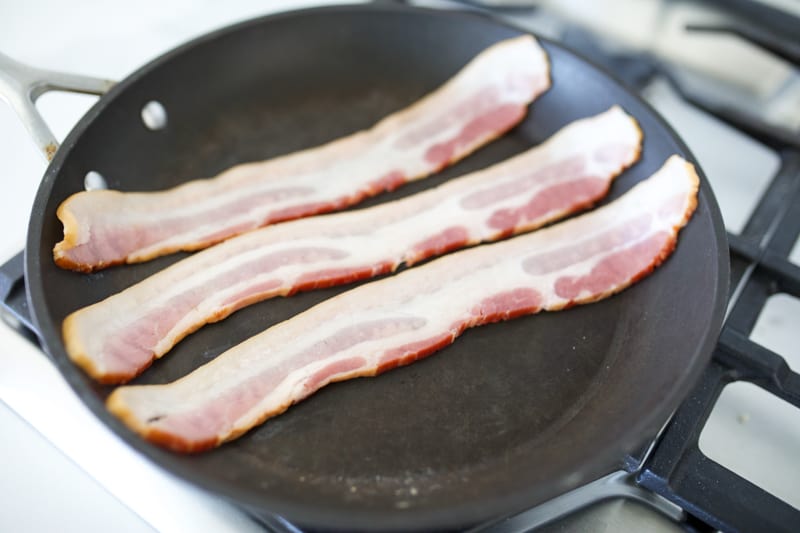
Refrigerator
If you don’t have a sous vide machine then defrosting in the refrigerator may be the best method, but it also takes several hours. If you’re in a rush, maybe not the quickest way to operate. But if you’re prepping breakfast the night before, this is the perfect method.
Refrigerator thawing is also the safest way of defrosting bacon, as the frozen meat thaws at a consistently low temperature. The bacon consistently stays at a food-safe temperature, keeping it fresh and safe for longer.
Here are a few simple steps to follow:
- Take the bacon packet out of the freezer and wrap it in a paper towel.
- Then place it on a plate or in a container to avoid leakage.
- Let it sit in the refrigerator for at least 6 hours or overnight.
This method requires some patience but drastically reduces the risk of foodborne illnesses. Once the bacon is completely defrosted, cook it immediately or leave it in the refrigerator for a couple of days.
Using Defrosted Bacon
Once bacon is defrosted, use it immediately or store it in the refrigerator for up to 2 days. The sooner the better!
Defrosted bacon can be used for making various dishes, whether for breakfast, lunch, or a quick snack. I love bacon so much that I simply pan-sear the bacon strips until they get nice and crispy. Then munch on them like a snack. But when I feel like having something more elaborate, I love making Starbucks-style bacon egg bites.
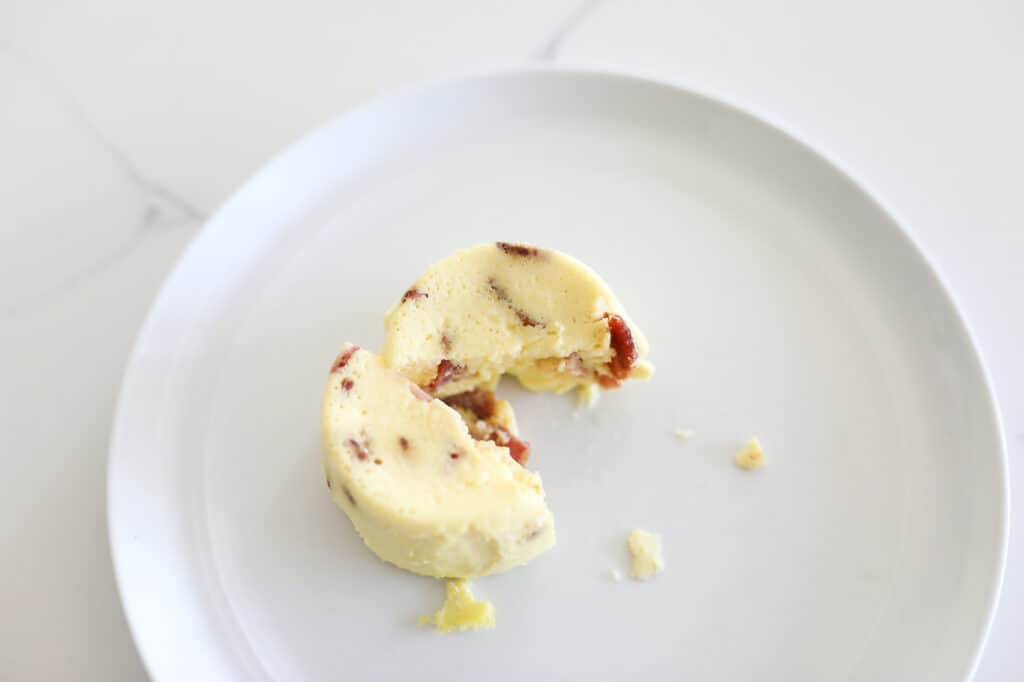
You can make a lot of recipes with defrosted bacon. A few of my favorites are:
- Eggs with Crispy Bacon. Simply fry the defrosted bacon and fried, scrambled, or poached eggs.
- Defrosted bacon bits can be used as a pizza topping or added to fried rice.
- Classic BLT Sandwich. Toasted bread with a smear of mayonnaise, defrosted bacon, lettuce, and tomato slices.
- Bacon bits are a great addition to soups, salads, pasta, or casseroles.
- Bacon-wrapped prawns or filet mignon if you want to make something fancy.
The Bottom Line
All the methods we covered differ in the time and equipment required to pull them off. Sous vide will get you the perfect doneness every time.
If you don’t have a basic sous vide setup (they’re less expensive than you’d expect), then I’d always recommend defrosting bacon in the refrigerator the night before. From a food safety standpoint, it is the superior method and will consistently get great results.
Or head to the microwave in a pinch because it’s the fastest way to defrost a few slices quickly. A frying pan will also work, although it’s not as quick and generally creates a bigger mess.
FAQs: How to Thaw Bacon Fast
Yes, you can cook frozen bacon. The best way of doing that is in a frying pan after separating the bacon strips using a knife. Use a skillet on medium heat, and ensure the bacon strips are arranged in a single layer.
Bacon thaws faster in cold water than letting it sit in the refrigerator for a few hours. Still, in most cases, this method offers less food safety. Try using a microwave or frying pan instead. Both ways are faster than doing it in cold water and take only a few minutes to defrost the bacon.
Yes. Defrosting bacon in hot water is a speedy and easy process. But this method has its own challenges. Thawing bacon in hot water may quickly raise the bacon’s temperature to the danger zone and increase the risk of food poisoning. The USDA food safety guidelines recommend keeping raw meat out of the danger zone of 40 to 140 degrees Fahrenheit as it encourages the growth of harmful bacteria.
